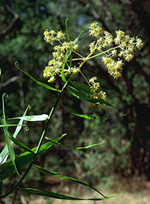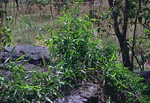 |
Flagellaria indica is the only representative in Australia of this
small family from the Old World tropics. It is usually found climbing
on rain forest edges and in gaps caused by falling trees, wherever there
is plenty of light and moisture, from coastal New South Wales to the Kimberley
region of Western Australia.
Characteristic features of the family Flagellariaceae in Australia include: - robust, bamboo-like, climbing herbs
- leaves linear, grass-like, with firm, coiled apices by which the plant climbs
- flowers usually in panicles, bisexual with 6 membranous perianth parts in 2 whorls, and 6 stamens
- fruit a drupe with a bony "stone" and a thin, fleshy outer layer
Description
Evergreen woody or perennial herbaceous vines climbing by tendrils. Tendrils terminating the leaf lamina. Perennating by rhizomes. Vegetative reproduction by rhizomes. Stem nodes conspicuously swollen; internodes solid or spongy or pithy. Internal secretions not obvious. Plants glabrous. Leaves alternate, spiral or distichous, cauline, subsessile or sessile. Stipule-like lobes absent. Lamina simple, symmetric, filiform, acicular, subulate or linear, with tip produced into a tendril; base cordate; margins entire, ±flat; venation parallel, with the midrib inconspicuous, and the tertiary venation reticulate or not; surfaces not punctate; herbaceous. Leaf ligule absent. All the flowers bisexual. Inflorescences terminal, consisting of panicles. Bracts and bracteoles present. Pollination by wind. Flowers odourless; stalked. Floral disc absent; nectaries absent. Perianth regular, of 2 ±similar whorls, with 6 free petaloid segments, imbricate in bud, white, without contrasting markings, membranous; claws absent; lobes ±entire. Fertile stamens 6, alternating with and opposite to and free of the perianth segments, free of the ovary and style, distinct from each other, all ±equal. Anthers basifixed, not versatile, opening sideways or inwards by longitudinal slits, 2-celled. Ovary superior and sessile. Carpels 3, fused; ovary with 3 locules. Style terminal, single and branched above or from the base. Ovules 1 per locule, sessile; placentation axile. Fruit a fleshy, indehiscent drupe; the perianth on the maturing fruit dry and persistent. Disseminule micro-surface ±smooth, or reticulate when dry, magenta, purple, violet, green or black, glossy or dull. Seeds 1–2 per fruit. Aril absent. Cotyledons 1. Embryo lens-shaped.
(Note: this description has been generated from the coded data compiled for the key. Any errors in the key data will be reflected in the descriptions.)
A treatment of the family Flagellariaceae has not yet been published in the Flora of Australia. It will appear in Volume 40.
Australian genera of Flagellariaceae (as recognised for the Flora of Australia)
Flagellaria

|
  |

Flagellaria indica (flowers)
Photo: J.Wrigley © ANBG

Flagellaria indica (habit)
Photo: anon © ANBG
|
 |
|